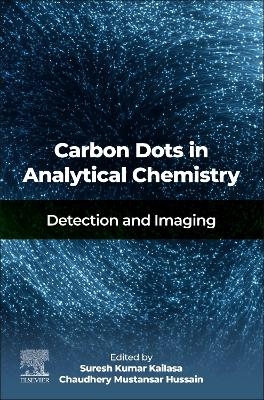
Carbon Dots in Analytical Chemistry
Elsevier - Health Sciences Division (Verlag)
978-0-323-98350-1 (ISBN)
The will be a valuable book for analytical and materials scientists, physical and chemical scientists, and engineers investigating the use of carbon nanomaterials in their analytical procedures.
Suresh Kumar Kailasa FRSC is an Associate Professor of the Department of Chemistry at Sardar Vallabhbhai National Institute of Technology (SVNIT) Surat, Gujrat, India. He obtained his master of science (Chemistry of Natural Products) in chemistry from Sri Krishnadeveraya University, Andhra Pradesh, India and his PhD in Chemistry from Sri Venkateswara University, Tirupati, Andhra Pradesh, India. After completing two Postdoctoral Fellowships at Chonbuk University, South Korea and at National Sun Yat-Sen University, Taiwan, he joined an Assistant Professor at SVNIT, Surat in 2009. He received Young Scientist Award from Taiwan Mass Spectrometry Society in 2013. He was selected as a Brain Pool Scientist at the Department of Chemistry, Chung-Ang University, South Korea under Korean Brain Pool Invitation Program of KOFST in 2017. He was selected as a Fellow of the Royal Society of Chemistry (FRSC), London, UK and Fellow of the Society of Pesticide Science India in 2019. He has been selected as a life member in the National Academy of Sciences (NASI) Allahabad, India. He acted as Guest Editors in the special issues in Applied Sciences (MDPI) and Materials Today Chemistry (Elsevier). Currently, he is the head of the Department of Chemistry, SVNIT, Surat, India. He is the author of 182 peer-reviewed papers and is the co-inventor of a Taiwan Patent. His research interest in the field of analytical chemistry, MALDI-MS, ESI-MS, microextraction, nanosensors, drug delivery, surface modifications of nanostructure materials, functional nanomaterials for the development of new analytical strategies. Chaudhery Mustansar Hussain is an Adjunct Professor and Director of laboratories in the Department of Chemistry & Environmental Sciences at the New Jersey Institute of Technology (NJIT), United States. His research is focused on the applications of nanotechnology and advanced materials, environmental management, analytical chemistry, and other various industries. Dr. Hussain is the author of numerous papers in peer-reviewed journals as well as a prolific author and editor of around 150 books, including scientific monographs and handbooks in his research areas.
Section 1: Synthetic Approaches and Properties of Carbon Dots
1. Top-down approaches for the preparation of carbon dots
2. Bottom-up approaches for the preparation of carbon dots
3. Unique properties of carbon dots
Section 2: Carbon Dots in Sample Preparation
4. Carbon dots in Sample Preparations
5. Carbon dots in extraction methods
Section 3: Carbon Dots in Analytical Techniques for the Detection of Chemical Species
6. Carbon dots in electrochemical tools
7. Carbon dots-based fluorescence spectrometry for metal ion sensing
8. Carbon dots-based fluorescence spectrometry for organic molecule sensing
9. Carbon dots in other analytical techniques
10. Carbon dots in hydrogels and their applications
11. Carbon dots as adsorbents for removal of toxic chemicals
Section 4: Carbon Dots in Imaging of Molecules and Cells
12. Ultra-small carbon dots for imaging of chemical species
13. Carbon dots-based microscopic techniques for imaging of cells
Section 5: Carbon Dots-based Analytical Tools for Biomedical and Food Analysis
14. Carbon nanomaterials based diagnostic tools
15. Carbon dots in food analysis
16. Toxicity of carbon dots
| Erscheinungsdatum | 09.09.2022 |
|---|---|
| Verlagsort | Philadelphia |
| Sprache | englisch |
| Maße | 216 x 276 mm |
| Gewicht | 450 g |
| Themenwelt | Naturwissenschaften ► Chemie ► Analytische Chemie |
| Technik ► Maschinenbau | |
| ISBN-10 | 0-323-98350-2 / 0323983502 |
| ISBN-13 | 978-0-323-98350-1 / 9780323983501 |
| Zustand | Neuware |
| Informationen gemäß Produktsicherheitsverordnung (GPSR) | |
| Haben Sie eine Frage zum Produkt? |
aus dem Bereich


